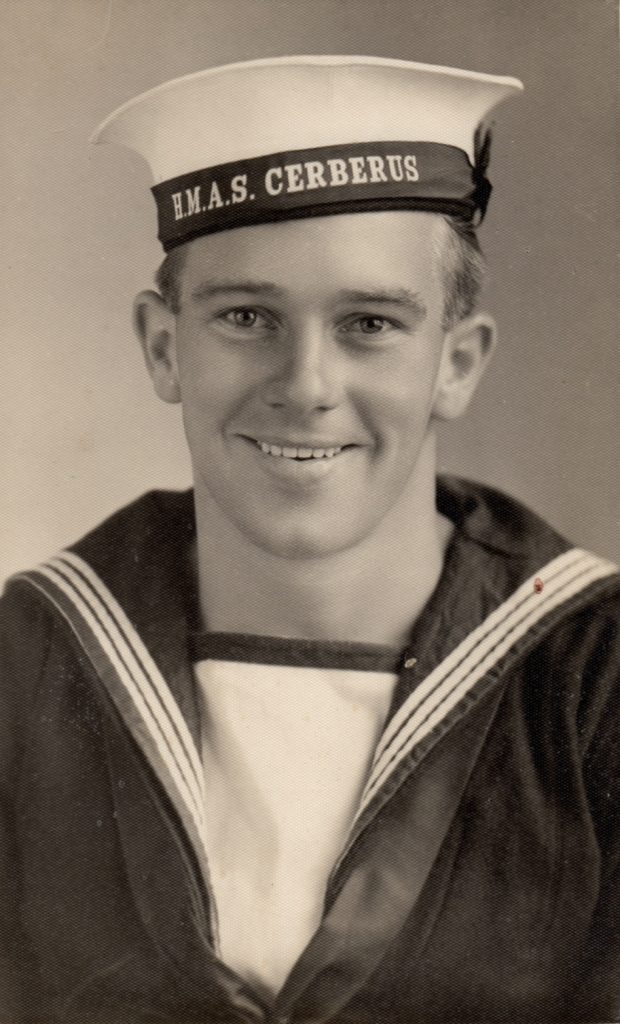
Douglas was born at Victor Harbor on 16 March 1922, second son of William Thomas Tugwell and Mary May Tugwell (nee Attrill). Doug as he was known, was educated at Victor Harbor Primary School and High School. He joined the Royal Australian Naval Reserve as an Ordinary Seaman on 27 January 1942. As a recruit he proceeded to HMAS Cerberus (Flinders Naval Depot) on Mornington Peninsula for recruit and gunnery training. Passing the Navy Educational Test in March 1942 was followed by his gunnery qualification on 13 May 1942. He remained at Cerberus until posted the Darwin Naval Depot, HMAS Melville on 13 July 1942.
Doug’s records do not indicate his shore duties in Darwin, but most likely he was at the Boom Depot, as he later served in two Boom Defence Vessels. These ships helped maintain and operate the Boom, which was a steel wire net stretched across the harbour entrance to prevent submarines from attacking shipping in the inner harbour. Soon after being promoted to Able Seaman on 12 December 1942, he joined Boom Defence Vessel HMAS Koala for five months then back to Melville for two months, followed by service in HMAS Kangaroo until 3 November 1943. After a short time back at Melville, he journeyed south, reaching Adelaide in time for Christmas leave and reassignment. While in Darwin Douglas would have experienced many of the 64 Japanese air raids, including the last one on 12 November 1943.
Returning to HMAS Torrens (Birkenhead Naval Depot) at the end of January 1944 from leave, Doug briefly served on the local patrol vessel Warralee before being sent to the Brisbane Naval Depot, HMAS Moreton, in mid-February. At Moreton, Douglas spent two months on HMAS Kinchela, a requisitioned small cargo ship used as the Boom gate tender for the Brisbane River.
Leaving Brisbane on 26 May 1944, Doug travelled via Townsville and Milne Bay to join the Tribal Class destroyer HMAS Warramunga on 20 June, while it was boiler-cleaning at Manus Island. On 29 June 1944 the ship sailed with Allied Task Force 74 for the 2 July amphibious landing at Noemfoor Island off Dutch New Guinea. Soon afterwards, Warramunga joined the cruiser HMAS Australia in shore bombardments. Later his ship, with American PT boats, conducted several night forays shooting at coastal barges and trucks driving along the shore near Karawop.
HMAS Warramunga and HMAS Australia returned to Sydney for refit (overhaul) during August 1944 before arriving back at Manus Island on 1 September to join Allied Task Forces, which were preparing for the amphibious landing at Morotai Island on 15 September. Warramunga was the first ship of its group to commence bombarding and later destroyed a Japanese barge. She returned to Manus Island with the Task Group for rest and maintenance prior to the coming Philippine landings. On 20 October 1944 the predominantly American forces, with over 400 ships, began the invasion landings at Leyte Gulf in the Philippines where Warramunga, being a destroyer, was an escort to one part of the bombardment force consisting of 3 USN battleships, 2 USN and 2 RAN cruisers. After the initial landing, Warramunga moved close to the shore to fire at set target areas. On 21 October HMAS Australia was badly damaged by a Kamikaze aircraft, which caused many casualties and was escorted back to Manus Island by Warramunga. Doug left the ship at Manus for return to Flinders Naval Depot, via Brisbane, to attend the Gun Layer 3 course conducted between 25 November 1944 and 25 February 1945.
After this course, he was drafted to Brisbane to join the crew standing by the new River Class anti-submarine frigate Diamantina nearing completion at Maryborough. The ship became HMAS when commissioned into the Royal Australian Navy on 27 April 1945. Following trials and operational training at Sydney, she arrived at Madang, New Guinea, on 23 June before sailing for Bougainville to spend much of July providing bombardment support along the northwest coast. Following maintenance at Manus Island, Diamantina returned to Bougainville to provide further naval gunfire support. VJ Day, 15 August 1945, found the ship at Madang.
On 8 September 1945, HMAS Diamantina carried Japanese General Kanda to Torokina to surrender Japanese forces on Bougainville. Diamantina then provided the surrender venue for Japanese Forces on Nauru Island, followed by Ocean Island, and escorted the merchant ships carrying the withdrawing Japanese soldiers.
Thereafter the ship was employed ferrying personnel and salvaged equipment between island ports and New Guinea, as part of the post war repatriation of Australian forces, until it returned to Sydney on 13 December 1945.
Douglas left the ship on 3 February 1946 for return to Adelaide. After a month at HMAS Torrenshe was discharged from the Navy on 8 March 1946.
Douglas William Tugwell died on 15 September 2002 and is buried in the Victor Harbor Cemetery.

References:
G Hermon Gill, Australia in the War of 1939 -1945, Royal Australian Navy, 1942-1945, Australian War Memorial, Canberra.
Australian War Memorial Collection..
Royal Australian Navy Website.
National Archives of Australia website – service file of PA2529 Douglas William Tugwell.
Compiled by the RSL Victor Harbor History Research Team, June 2016.

